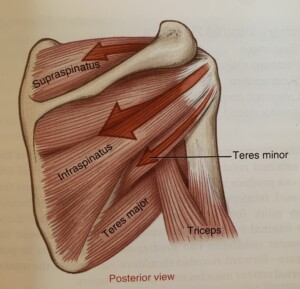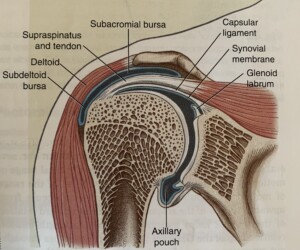Almost two months into PTA school and we are flying through so much material at times it’s hard to keep up. One thing we just covered however is your rotator cuff. You might not know much about your shoulder muscles, or your shoulder function in general, but today we are going to change that!
 The number one reason people consult a physician about shoulder pain is for rotator cuff problems. A torn rotator cuff will weaken your shoulder. This means that many daily activities, like combing your hair or getting dressed, may become painful and difficult to do. Your rotator cuff is comprised of 4 muscles and in PTA school we learned it through S.I.T.S:
The number one reason people consult a physician about shoulder pain is for rotator cuff problems. A torn rotator cuff will weaken your shoulder. This means that many daily activities, like combing your hair or getting dressed, may become painful and difficult to do. Your rotator cuff is comprised of 4 muscles and in PTA school we learned it through S.I.T.S:
- Supraspinatus
- Infraspinatus
- Teres Minor
- Subscapularis
Shoulder anatomy
To understand how these muscles above work together, lets start with the general anatomy of your shoulder. Three bones make up your shoulder joint. This consists of your clavicle (collarbone), humerus (upper arm), and scapula (shoulder blade). Because the shoulder is a ball-and-socket joint, the head of your humerus sits into a shallow socket of your scapula. The rotator cuff muscles help keep your arm in this shoulder socket and helps to lift and rotate your arm.
The 4 muscles S.I.T.S come together as tendons to form a covering around the head of the humerus. Then the bursa (a lubricating sac between the rotator cuff and acromion of the scapula) allows the rotator cuff tendons to glide freely when you move your arm. When these rotator cuff tendons become injured/damaged, the bursa may also become inflamed and painful.
rotator tears
When one or more of the rotator cuff tendons is torn, the tendon no longer fully attaches to the head of the humerus. Most tears occur in the supraspinatus tendon, but other parts of the rotator cuff may also be involved. In many cases, torn tendons begin by fraying. As the damage progresses, the tendon can completely tear (occurs away from the bone), sometimes with lifting a heavy object.
- Partial Tear
- This type of tear is also called an incomplete tear. It damages the tendon, but does not completely sever it.
- Full-thickness Tear
- This type of tear is also called a complete tear. It separates all of the tendon from the bone. With a full-thickness tear, there is basically a hole in the tendon.
- Acute Tear
- This type of tear occurs with other shoulder injuries, such as a broken collarbone or dislocated shoulder.
- Degenerative Tear
- Most tears become a result of the tendon wearing down over time. This degeneration naturally occurs as we age. Rotator cuff tears are more common in the dominant arm. If you have a degenerative tear in one shoulder, there is a great chance a rotator cuff tear occurs in the opposite shoulder.
what causes a tear
There are a variety of factors that contribute to rotator tears.
- Repetitive stress
- Doing the same shoulder motions over and over can stress your rotator cuff muscles and tendons. Sports such as baseball, tennis, rowing, and weightlifting are examples that can put you at risk for overuse tears. Many jobs and routine chores may also cause overuse tears too.
- Lack of blood supply
- As you age, the blood supply in the rotator cuff tendons lessen. Without a good blood supply, the body’s natural ability to repair tendon damage is impaired. Ultimately this may and will lead to a tendon tear.
- Bone spurs
- Bone spurs (bone overgrowth) often develop on the underside of the acromion bone. Lift your arms and the spurs rub on the rotator cuff tendon. This is called shoulder impingement, and over time may weaken the tendon and cause it to tear.
signs and symptoms
While there are a variety of signs and symptoms, the most common symptoms include:
- Pain when resting, particularly if lying on the affected shoulder
- Pain when lowering or lifting your arm in general or with specific movements
- To add on to the previous bullet, you may also feel weakness when lowering or lifting your arm
- A crackling sensation when moving your shoulder or moving it to certain positions
Tears that occur suddenly from a fall or other injurys typically cause intense pain. You will possibly feel a sensation and immediate weakness in your upper arm, same for a tear that develops slowly due to overuse of the shoulder. Over-the-counter medication, such as aspirin or ibuprofen, may relieve the pain at first. However, as time progresses, the pain may be more noticeable at rest, and doesn’t stop with medications. At this point, you should check in with a doctor/physician if you haven’t already.
treatment
Early treatment can prevent your symptoms from getting worse. It also helps get you back to your daily routine quicker! Physical therapy is a great treatment option. Not only will your therapist work with you and set goals to get you back to where you want to be, but they can design a treatment plan that includes exercises tailored to you.


